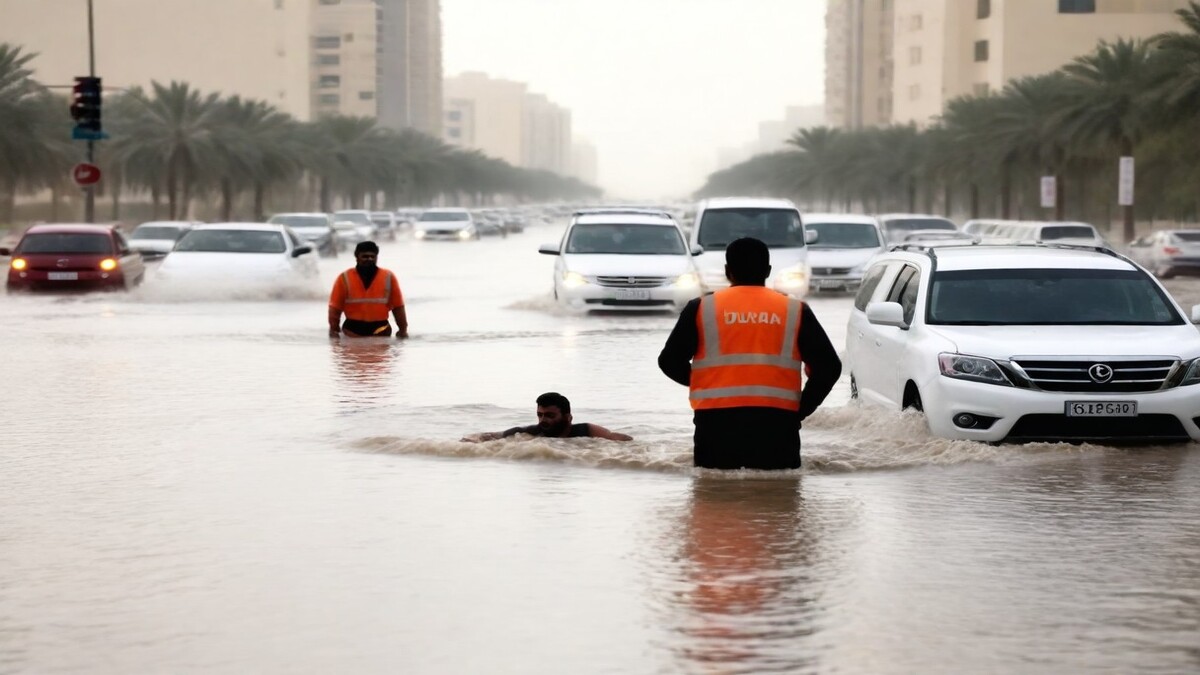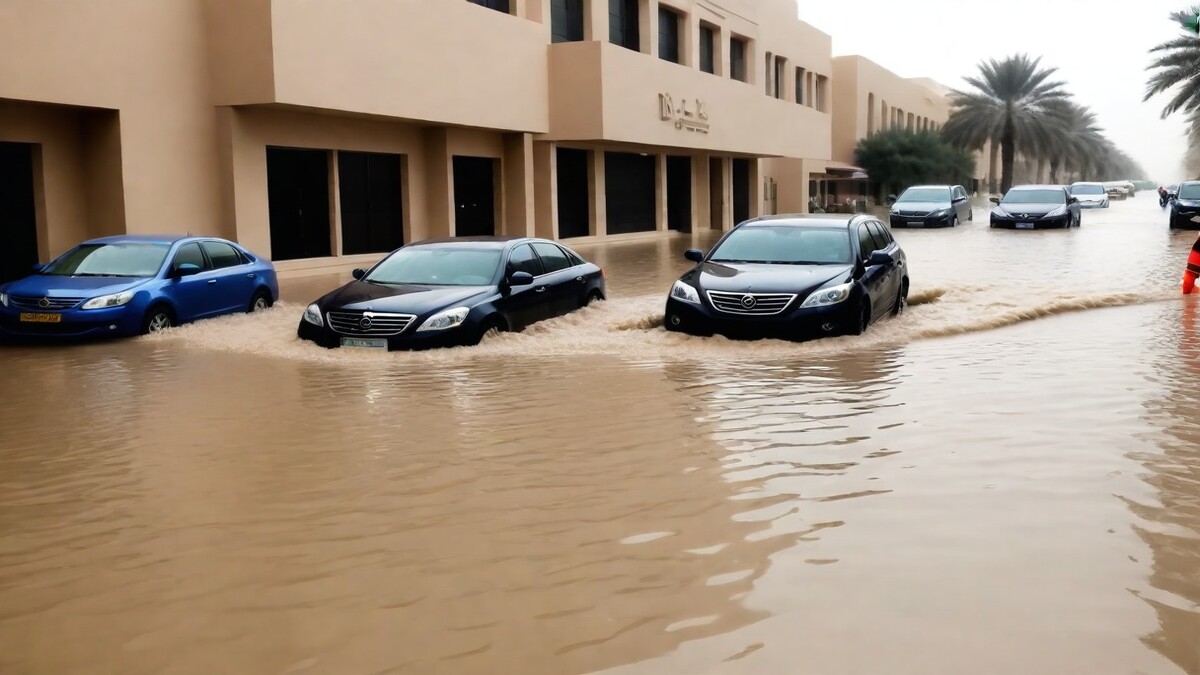Dubai Floods and the Middle East: A region synonymous with scorching sands and arid landscapes, witnessed a dramatic shift in weather patterns within a year of the event. Heavy rain, an anomaly in this parched part of the world, triggered rare and devastating floods across Oman, Dubai (UAE), and other parts of the region. This event, a stark reminder of the growing impact of climate change, left a trail of destruction and highlighted the vulnerability of desert ecosystems to extreme weather.
A Deluge in the Desert: Dubai Floods Causes
The unprecedented downpour that lashed the Middle East can be attributed to a confluence of factors:
Cyclone Shaheen: A powerful cyclone formed in the Arabian Sea, triggering a convergence of warm, moist air masses over the region. This led to the condensation of large amounts of water vapor into rain clouds, resulting in heavy rainfall.
La Niña: This global climate pattern, characterized by cooler-than-average sea surface temperatures in the equatorial Pacific Ocean, can influence weather patterns worldwide. In this case, La Niña may have contributed to increased instability in the atmosphere, further amplifying the effects of Cyclone Shaheen.
Climate Change: While a single weather event cannot definitively be linked to climate change, rising global temperatures are expected to increase the frequency and intensity of extreme weather events, including heavy precipitation.
A Region Under Water: Impacts of the Flooding
The consequences of the heavy rain and flooding were far-reaching:
Loss of Life: Sadly, the floods claimed the lives of at least 18 people, with Oman bearing the brunt of the casualties.
Infrastructure Damage: Roads, bridges, and buildings were severely damaged, disrupting transportation networks and displacing residents. Dubai’s international airport, a vital hub for global travel, was temporarily shut down due to flooding on the tarmac.
Property Damage: Homes and businesses were inundated with water, causing extensive damage to property and belongings.
Environmental Concerns: The floods flushed pollutants and debris into waterways, posing a threat to marine life and water quality.
A Tale of Two Cities: Dubai Floods vs. Oman Floods
While both Dubai and Oman experienced heavy rain and flooding, the scale and impact differed significantly:
Dubai: Dubai, with its advanced infrastructure and disaster preparedness plans, was able to mitigate the effects of the floods to some extent. However, the city still faced significant disruptions and infrastructure damage.
Oman: Oman, a less developed country with limited resources, suffered far greater devastation. The floods caused widespread damage to infrastructure, homes, and agricultural land. The country’s response and recovery efforts were also hampered by a lack of resources.
The Road to Recovery
The Middle East is now grappling with the aftermath of these floods. Predictions suggest:
Short-Term: The focus will be on immediate relief efforts, including providing shelter, food, and medical care to those affected. Repairing damaged infrastructure will also take time and resources.
Long-Term: The region needs to invest in stronger infrastructure that can withstand extreme weather events. Additionally, there’s a need for improved disaster preparedness plans and climate change adaptation strategies.
FAQs: Heavy Rain and Flooding in the Middle East
Has the Middle East ever experienced such heavy rainfall before?
While heavy rain events are rare, they are not unheard of. However, the scale and intensity of the recent downpour were unprecedented.
What role did climate change play in the floods?
Climate change is likely to have exacerbated the effects of Cyclone Shaheen, making extreme weather events like this more frequent and intense.
How will the floods impact the region’s economy?
The damage to infrastructure and disruption of business activity will undoubtedly hurt the region’s economy.
What can be done to prevent future flooding disasters?
Investing in resilient infrastructure, improving disaster preparedness plans, and adapting to climate change are crucial steps.
How can I help with the relief efforts?
Several organizations are working to assist those affected. You can donate to these organizations or volunteer your time and skills.
Will this event change the way cities in the Middle East are built?
The floods are likely to prompt a reevaluation of urban planning and infrastructure development, with a focus on building resilience to extreme weather events.
What are the long-term environmental consequences of the Dubai floods?
The floods may have caused pollution and damaged ecosystems, requiring long-term environmental restoration efforts.
How will this event impact tourism in the region?
The impact on tourism will likely be short-term. Dubai, with its robust infrastructure and focus on tourism, is expected to recover quickly. However, Oman’s tourism industry may face a more significant challenge, depending on the extent of damage to tourist infrastructure and the speed of recovery efforts.
Are there any concerns about waterborne diseases after the floods?
Yes, there is a risk of waterborne diseases spreading in the aftermath of dubai floods, particularly in areas with compromised sanitation systems. Access to clean water and proper hygiene practices are crucial to preventing outbreaks.
What lessons can be learned from this event for other arid regions?
The floods serve as a stark warning for other arid regions vulnerable to climate change. Investing in resilient infrastructure, early warning systems and disaster preparedness plans is essential to mitigate the impact of future extreme weather events.
A Wake-up Call from the Desert
The unprecedented heavy rain and Dubai floods in the Middle East serve as a stark reminder of the vulnerability of our planet to climate change. The event highlights the need for immediate action to mitigate the effects of climate change and adapt to a future with more frequent and intense weather extremes. It’s a call for stronger international cooperation to support vulnerable nations and invest in sustainable development strategies. As the Middle East rebuilds, the lessons learned from this event will be crucial in shaping a more resilient future for the region and the world.






